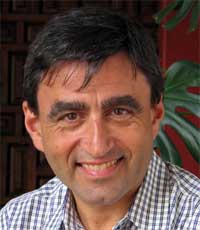- Eric Mazur
Infobox_Scientist
name = Eric Mazur

image_width = 200px
caption = Eric Mazur
birth_date = Birth date and age|1954|11|14|mf=y
birth_place =Amsterdam ,the Netherlands
death_date =
death_place =
residence =
nationality =
field =Physicist
work_institution =Harvard University
alma_mater =Leiden University (doctoral)Harvard University (postdoctoral)
doctoral_advisor =Jan Beenakker (doctoral)Nicolaas Bloembergen (postdoc)
doctoral_students =
known_for = Ultrasfast PhenomenaPeer Instruction
prizes = Presidential Young Investigator Award (1988)
footnotes =Eric Mazur (b.
November 14 ,1954 ) is a prominentphysicist andeducator atHarvard University . Mazur is known for his work in experimental ultrafast optics andcondensed matter physics and a national leader in science education. Born inAmsterdam ,the Netherlands , he received his undergraduate and degrees fromLeiden University inthe Netherlands .Education
Mazur studied physics and astronomy at
Leiden University . He passed his "doctoraal examen" (equivalent to aMasters degree ) in 1977 and continued his graduate studies at the same institution. In 1981 he obtained his Ph. D on a thesis entitled "The structure of non-equilibrium angular momentum polarizations in polyatomic gases". Although he intended to go on to a career in industry withPhilips N.V. inEindhoven , he left Europe at the urging of his father,Peter Mazur , to pursue a postdoctoral study with recent Nobel laureateNicolaas Bloembergen atHarvard University .Career
After two years as a postdoc, Mazur was offered a position of
Assistant Professor atHarvard University . In 1987 he was promoted toAssociate Professor and obtainedtenure three years later in 1990. Mazur currently holds a chair as Gordon McKay Professor ofApplied Physics in the Harvard School of Engineering and Applied Sciences and Professor of Physics in the Faculty of Arts and Sciences.Research
Mazur's early work at Harvard focused on the use of short-pulse
lasers to carry outspectroscopy of highly vibrationally excitedmolecules . Mazur and his group have made many pioneering contributions to the field of ultrashort laser pulses and their interactions with matter ("femtosecond material science"). In 1989 his group was one of the first in academia to build a colliding-pulse mode-lockedlaser , which generated pulses of only 70femtosecond duration. After early measurements by Mazur’s group demonstrated conclusively that solids can undergo a structural phase transition without appreciable heating of thelattice , Mazur’s group developed a technique to measure the fulldielectric function of highly excitedsemiconductors . Since then the group’s use of this technique and various nonlinear optical probes to study laser-induced structuralphase transitions .In parallel to the work on semiconductors, Mazur began studying the interaction of intense femtosecond pulses with transparent materials. By tightly focusing a laser pulse in the bulk of a transparent material nonlinear optical
absoprtion occurs inside the material, leading to extreme high temperatures and material changes at the focus. This femtosecond laser micromachining technique is now widely used for fordata storage , fabrication of integrated optical components, and microsurgery.of silicon. The material has found commercial applications in a number of photodetectors.
Mazur's research continues to focus on ultrashort laser pulse interactions and novel nonlinear optical devices. In collaboration with a group from
Zhejiang University inHangzhou ,China , Mazur's group was the first to develop a technique for pulling subwavelength diametersilica optical fibers . These wires guide light in the form of anevanescent wave , permit very sharp bending of the light.Peer instruction
In 1991, Mazur began designing an instructional strategy for teaching called
peer instruction . In 1997, he published a book called "Peer Instruction: A User's Manual" which provides details on this strategy.Awards
Mazur has been widely recognized for his scientific work and leadership.
* 1988 - He was awarded the Presidential Young Investigator Award by President
Ronald Reagan .
* 1989 - Elected Fellow of theAmerican Physical Society .
* 1999 - Award for excellence in educational research by the [http://www.cssp.us/ Council of Scientific Society Presidents]
* 2006 - selected as one of 75 most outstanding Americanphysicists by theAmerican Association of Physics Teachers References
* Mazur, E. (1997). "Peer Instruction: A User's Manual", Prentice Hall. ISBN 0-13-565441-6
External links
* [http://mazur-www.harvard.edu/ Mazur Group] at
Harvard University
* [http://hseas.harvard.edu/ourfaculty/profile/Eric_Mazur Eric Mazur's profile at Harvard]
* [http://www.physics.harvard.edu/people/facpages/mazur.html Eric Mazur's physics profile at Harvard]
Wikimedia Foundation. 2010.
